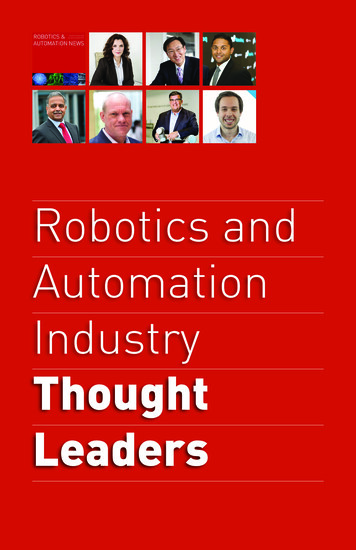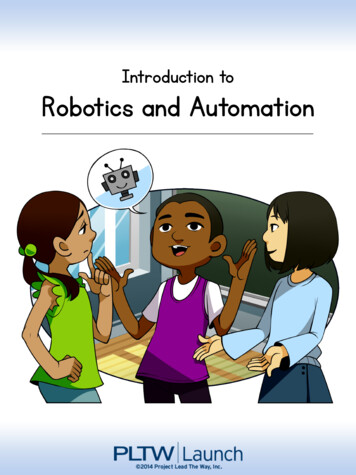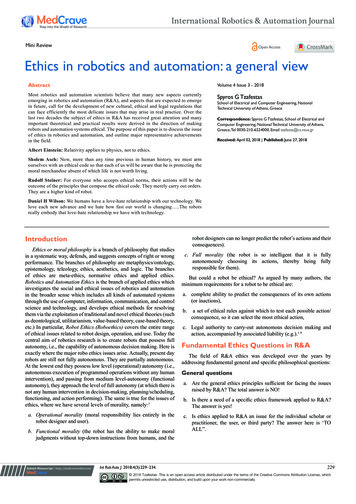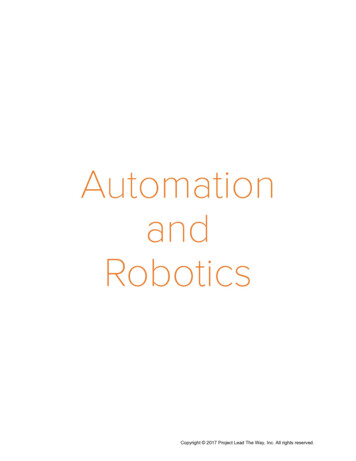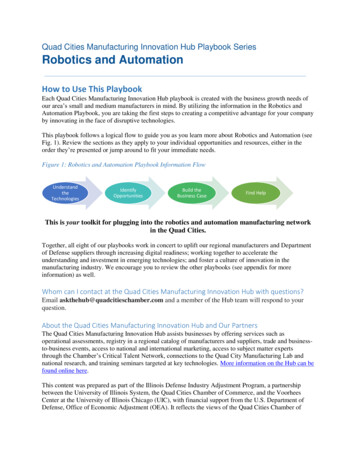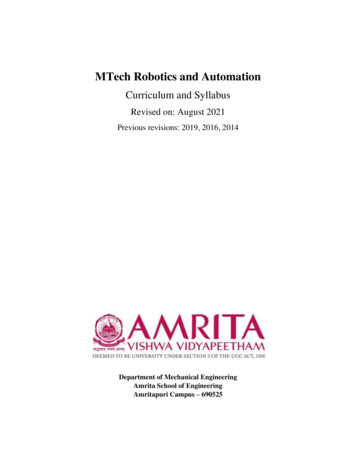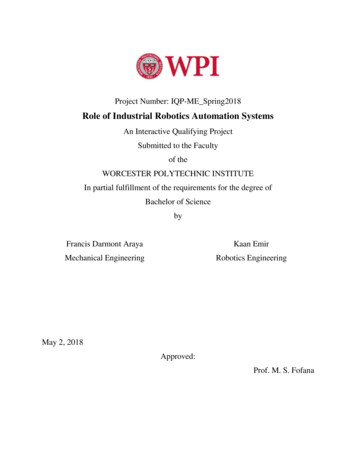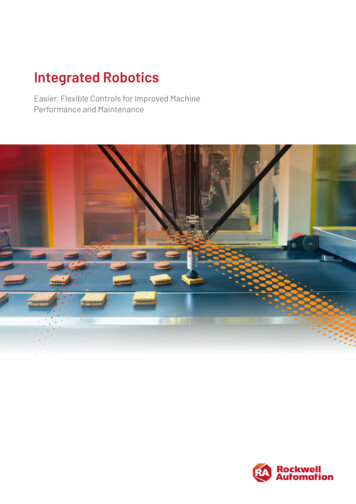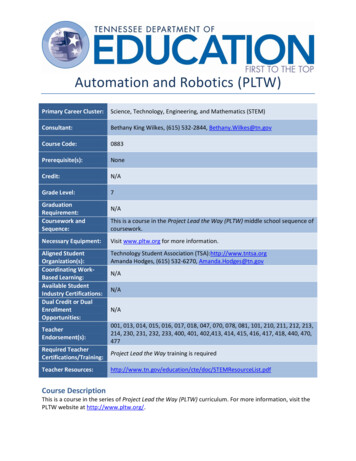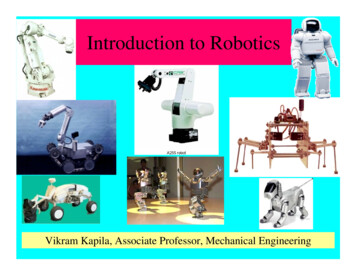
Transcription
Introduction to RoboticsVikram Kapila, Associate Professor, Mechanical Engineering
Outline DefinitionTypesUsesHistoryKey componentsApplicationsFutureRobotics @ MPCRL
Robot Defined Word robot was coined by aCzech novelist Karel Capek in a1920 play titled Rassum’sUniversal Robots (RUR) Robot in Czech is a word forworker or servantzDefinitionKarel Capekof robot:–Any machine made by by one our members: Robot Instituteof America -–A robot is a reprogrammable, multifunctional manipulatordesigned to move material, parts, tools or specialized devicesthrough variable programmed motions for the performance ofa variety of tasks: Robot Institute of America, 1979
Types of Robots: IManipulator
Types of Robots: IILegged RobotWheeled Robot
Types of Robots: IIIAutonomous Underwater VehicleUnmanned Aerial Vehicle
Robot Uses: IJobs that are dangerousfor humansDecontaminating RobotCleaning the main circulating pumphousing in the nuclear power plant
Robot Uses: IIRepetitive jobs that areboring, stressful, or laborintensive for humansWelding Robot
Robot Uses: IIIMenial tasks that humandon’t want to doThe SCRUBMATE Robot
Laws of Robotics Asimov proposed three “Laws ofRobotics” and later added the“zeroth law”Law 0: A robot may not injurehumanity or through inaction,allow humanity to come to harmLaw 1: A robot may not injure ahuman being or through inaction,allow a human being to come toharm, unless this would violate ahigher order lawLaw 2: A robot must obey ordersgiven to it by human beings, exceptwhere such orders would conflictwith a higher order lawLaw 3: A robot must protect itsown existence as long as suchprotection does not conflict with ahigher order law
History of Robotics: I The first industrialrobot: UNIMATE 1954: The first programmablerobot is designed by GeorgeDevol, who coins the termUniversal Automation. He latershortens this to Unimation, whichbecomes the name of the firstrobot company (1962).UNIMATE originally automated themanufacture of TV picture tubes
History of Robotics: II1978: The Puma (ProgrammableUniversalMachineforAssembly) robot is developedby Unimation with a GeneralMotors design supportPUMA 560 Manipulator
History of Robotics: III1980s: The robot industry enters a phase of rapid growth. Manyinstitutions introduce programs and courses in robotics. Roboticscourses are spread across mechanical engineering, electricalengineering, and computer science departments.Adept’s SCARA robotsCognex In-Sight RobotBarrett Technology Manipulator
History of Robotics: IV1995-present: Emergingapplications in smallroboticsandmobilerobots drive a secondgrowthofstart-upcompanies and research2003: NASA’s Mars Exploration Rovers will launch towardMars in search of answers about the history of water on Mars
Knowledgebase for Robotics Typical knowledgebase for the design and operation of roboticssystems–Dynamic system modeling and analysis–Feedback control–Sensors and signal conditioning–Actuators (muscles) and power electronics–Hardware/computer interfacing–Computer programmingDisciplines: mathematics, physics, biology,mechanical engineering, electrical engineering,computer engineering, and computer science
Key ComponentsPower conversionunitSensorsActuatorsControllerUser interfaceManipulator linkageBase
Robot Base: Fixed v/s MobileRobotic manipulators used inmanufacturing are examples offixed robots. They can notmove their base away from thework being done.Mobile bases are typicallyplatforms with wheels or tracksattached. Instead of wheels ortracks, some robots employlegs in order to move about.
Robot MechanismMechanical Elements
Sensors Human senses: sight, sound, touch, taste, and smellprovide us vital information to function and survive Robot sensors: measure robot configuration/conditionand its environment and send such information to robotcontroller as electronic signals (e.g., arm position,presence of toxic gas)AccelerometerUsing Piezoelectric Effect Robots often need information that is beyond 5 humansenses (e.g., ability to: see in the dark, detect tinyamounts of invisible radiation, measure movement that istoo small or fast for the human eye to see)Flexiforce Sensor
Vision SensorsVision Sensor: e.g., to pick bins,perform inspection, etc.Part-Picking: Robot can handlework pieces that are randomly piledby using 3-D vision sensor. Sincealignment operation, a special partsfeeder, and an alignment palleteare not required, an automaticsystem can be constructed at lowcost.In-Sight Vision Sensors
Force SensorsForce Sensor: e.g., partsfitting and insertion,force feedback in roboticsurgeryPartsfittingandinsertion:Robots can do precise fitting andinsertion of machine parts by usingforce sensor. A robot can insert partsthat have the phases after matchingtheir phases in addition to simplyinserting them. It can automate highskill jobs.
Proximity SensorsExampleInfrared Ranging SensorKOALA ROBOT 6 ultrasonic sonar transducers to explore wide, open areas Obstacle detection over a wide range from 15cm to 3m 16 built-in infrared proximity sensors (range 5-20cm) Infrared sensors act as a “virtual bumper” and allow fornegotiating tight spaces
Tilt SensorsTilt sensors: e.g., to balance a robotExampleTilt SensorPlanar Bipedal Robot
Actuators/Muscles: I Common robotic actuators utilize combinations ofdifferent electro-mechanical devices–––––Synchronous motorStepper motorAC servo motorBrushless DC servo motorBrushed DC servo motorhttp://www.ab.com/motion/servo/fseries.html
Actuators/Muscles: IIPneumatic CylinderHydraulic MotorStepper MotorDC MotorPneumatic MotorMuscle WireServo Motor
ControllerzzProvide necessary intelligence to control themanipulator/mobile robotProcess the sensory information and compute thecontrol commands for the actuators to carry outspecified tasks
Storage HardwareStorage devices: e.g., memory to store thecontrol program and the state of the robot systemobtained from the sensors
Computation HardwareComputational engine that computes the controlcommandsRoboBoard Robotics ControllerBASIC Stamp 2 Module
Interface HardwareInterface units:Hardware to interface digitalcontroller with the external world (sensors and actuators)Operational AmplifiersAnalog to Digital ConverterLM358LM358LM1458 dual operational amplifier
Robots in Industry Agriculture Automobile Construction Entertainment Health care: hospitals, patient-care, surgery , research, etc. Laboratories: science, engineering , etc. Law enforcement: surveillance, patrol, etc. Manufacturing Military: demining, surveillance, attack, etc. Mining, excavation, and exploration Transportation: air, ground, rail, space, etc. Utilities: gas, water, and electric Warehouses
Industrial Applications of Robots Material handling Material transfer Machine loading and/orunloading Spot welding Continuous arc welding Spray coating Assembly InspectionMaterial Handling ManipulatorAssembly ManipulatorSpot Welding Manipulator
Robots in SpaceNASA Space Station
Robots in Hazardous EnvironmentsTROV in Antarcticaoperating under waterHAZBOT operating inatmospheres containingcombustible gases
Medical RobotsRobotic assistantmicro surgeryfor
Robots in MilitaryPREDATORSPLIT STRIKE:Deployed from asub’s hull, Mantacould dispatch tinymine-seeking AUVsor engage in moreexplosive combat.ISTARGLOBAL HAWKGOLDENEYE
Robots at HomeSony SDR-3X Entertainment RobotSony Aido
Future of Robots: IArtificial IntelligenceCogKismet
Future of Robots: IIAutonomyRobot Work CrewsGarbage Collection Cart
Future of Robots: IIIHumanoidsHONDA Humanoid Robot
Robotics @ MPCRL:Remote Robot Arm Manipulation
Robotics @ MPCRL:Smart Irrigation System
Robotics @ MPCRL: RoboDry
Robotics @ MPCRL:4-Legged Hexapod
Robotics @ MPCRL: Hexapodfor Disaster Recovery
Robotics @ MPCRL: Hexapodfor Disaster Recovery
Robotics @ MPCRL:Robotic Vacuum Cleaner
Robotics @ MPCRL:Automated Distinguisher
Robotics @ MPCRL:Automated Distinguisher
To Explore FurtherVisit:http://mechatronics.poly.edu
Laws of Robotics Asimov proposed three “Laws of Robotics” and later added the “zeroth law” Law 0: A robot may not injure humanity or through inaction, allow humanity to come to harm Law 1: A robot may not injure a human being or through inaction, allow a human being to c
